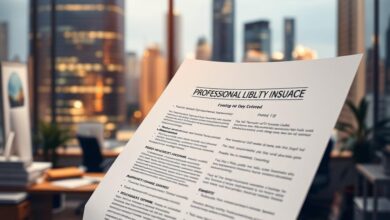A Guide to Professional Errors and Omissions Insurance
In today’s world, professionals and businesses face many risks. These risks can cause financial loss and harm their reputation. E&O insurance, or professional liability insurance, is a key protection against these risks. It helps cover claims of negligence, misrepresentation, or duty breaches.
Having the right insurance coverage can save you from financial disaster. We’ll dive into professional errors and omissions insurance. We’ll look at its importance, benefits, and how it fits different professions.
Key Takeaways
- Understanding the role of E&O insurance in protecting professionals and businesses.
- Recognizing the importance of professional liability insurance in today’s litigious environment.
- Identifying the benefits of having E&O insurance for various professions.
- Learning how to tailor E&O insurance to meet specific business needs.
- Appreciating the financial protection offered by E&O insurance against costly lawsuits.
What Is Professional Errors and Omissions Insurance
In the world of professional services, Errors and Omissions insurance is key. It protects against claims of negligence or errors. This insurance, also known as professional liability insurance, helps individuals and businesses avoid financial loss from mistakes or omissions in their services.
Core Coverage Components
E&O insurance covers various costs linked to claims of professional negligence. This includes legal fees, damages, and other related expenses. The main parts of E&O coverage are:
- Defense costs for lawsuits related to professional services
- Damages or settlements from claims of negligence or errors
- Coverage for lost income or extra expenses due to a claim
E&O vs. General Liability: Key Differences
E&O and general liability insurance both protect against financial losses. But they serve different purposes. General liability insurance covers bodily injury, property damage, and other non-professional liabilities. On the other hand, E&O insurance focuses on claims related to professional services and advice.
| Insurance Type | Coverage Focus | Typical Claims |
|---|---|---|
| Errors and Omissions (E&O) | Professional services and advice | Negligence, errors, or omissions in professional services |
| General Liability | Bodily injury, property damage | Slip and fall accidents, property damage during operations |
Identifying Your Business’s E&O Insurance Needs
It’s key to know what E&O insurance your business needs. This is to shield your company from financial dangers. Risks can come from many places, like dealing with clients, how you deliver services, and contracts.
Assessing Your Professional Liability Risks
Think about the services you offer and the chance for mistakes. If you give advice or consult, you might face more risks. Look at your clients, the complexity of your work, and any past claims.
Key factors to consider include:
- The nature of your professional services
- The volume of clients you serve
- The chance for disputes or claims
Warning Signs Your Business Is Underprotected
Some signs show your business might not have enough protection. These are more client complaints, new rules in your field, or more lawsuits against similar companies. Check your E&O insurance often to make sure it’s right for your business.
Keep an eye out and update your insurance as your business grows.
Who Needs Professional Errors and Omissions Insurance
E&O insurance is key for those who give advice and help to clients. It keeps their reputation and finances safe. It’s very important for many professionals, mainly in service and tech fields.
Service-Based Professionals
Professionals in medical, legal, financial, and real estate need E&O insurance. It protects them from claims.
Medical and Legal Practitioners
Doctors and lawyers face claims for their advice or services. E&O insurance reduces these risks.
Financial and Real Estate Advisors
Financial and real estate experts also need E&O insurance. It guards them against claims of negligence or errors in advice.
Technology and Digital Service Providers
Those in tech and digital services, like software developers and IT consultants, need E&O insurance. It protects them from claims about their services.
Software Developers and IT Consultants
Software developers and IT consultants face risks in their digital work. E&O insurance is a key part of managing these risks.
Marketing and Media Professionals
Marketing and media folks also need E&O insurance. It helps protect them from claims about their campaigns and services.
| Profession | E&O Insurance Need | Risk Exposure |
|---|---|---|
| Medical Practitioners | High | Malpractice claims |
| Software Developers | High | Data breaches, coding errors |
| Financial Advisors | High | Investment advice errors |
How to Determine Your Optimal Coverage Level
To make sure you’re covered well, you need to figure out the right amount of E&O insurance. You must know your business’s risks and financial health.
Step1: Evaluate Your Client Contracts
First, look at your client contracts for risks. Check for clauses that could raise your risk, like indemnification agreements. Reviewing these contracts carefully will show you how much coverage you need.
Step2: Analyze Industry-Specific Claim Amounts
Then, check out claim amounts in your industry. Look at reports and insurance data to see average claim costs. This will help you find a good coverage limit.
| Industry | Average Claim Amount | Recommended Coverage Limit |
|---|---|---|
| Technology | $100,000 | $1 million – $2 million |
| Healthcare | $200,000 | $2 million – $5 million |
| Finance | $500,000 | $5 million – $10 million |
By following these steps, you can find the best coverage for your business. This will help protect it from financial risks.
Step-by-Step Guide to Purchasing E&O Insurance
Buying Errors and Omissions (E&O) insurance might seem hard. But, breaking it down into simple steps makes it easier. To get the right coverage, follow a clear plan.
Step1: Research Specialized Insurance Providers
First, look for insurance companies that focus on E&O insurance. Choose ones with a good reputation and know your industry well. Specialized providers can offer policies that fit your needs better.
Step2: Gather Required Documentation
Next, collect all the documents you need. You’ll likely need to share business info, service details, and financial records. Having these ready can speed up your application.
Step3: Compare Policy Terms and Exclusions
After getting quotes, compare the policies’ terms and what’s not covered. Look at coverage limits, deductibles, and exclusions. Comparing policies helps you find the best one for your business.
By following these steps, you can buy E&O insurance with confidence. The aim is to find a policy that protects your business well.
Understanding E&O Insurance Cost Factors
Knowing what affects E&O insurance costs is key for businesses. Several important factors influence the final price. It’s vital for companies to understand these to manage their insurance costs better.

Industry Risk Classification Impact
The type of business a company has greatly affects its E&O insurance cost. Businesses in high-risk fields like healthcare or finance usually pay more. This is because they face a higher chance of needing to make claims.
Revenue and Business Size Considerations
The size and how much money a business makes also matter. Usually, bigger businesses with more income pay more for insurance. This is because they are more likely to face big claims.
Deductible and Coverage Limit Effects
The deductible and coverage limits a business chooses can change its insurance costs. Picking higher deductibles or lower coverage can lower premiums. But, businesses need to think about how much risk they can handle and their budget.
By knowing these factors, businesses can make smarter choices about their insurance. This can help them save money on their E&O insurance.
How to File and Navigate an E&O Insurance Claim
Filing an E&O insurance claim can seem tough. But knowing the steps can make it easier. When a claim happens, it’s key to act fast and follow the right steps for a smooth process.
Immediate Steps After a Possible Claim Situation
When you think there might be a claim, tell your insurance company right away. You can call or email them first, then send a written statement. Make sure to write down all important details like dates, times, and who was involved.
Documentation Needs and Deadlines
When you file a claim, you’ll need some documents. These might include contracts, emails, and service details. Here’s a table with common documents and deadlines:
| Documentation | Deadline |
|---|---|
| Initial Notification | Within 30 days of claim awareness |
| Written Statement | Within 60 days of initial notification |
| Supporting Documents | Within 90 days of written statement |
Knowing what documents you need and when they’re due is important. Being ready and quick can help your claim go smoothly.
Protecting Your Professional Future
Professional errors and omissions insurance is key for businesses and professionals. It protects against claims of negligence or mistakes in services. This insurance is a must for a solid risk management plan.
E&O insurance shields professionals from costly lawsuits. Even if claims are wrong, the financial hit can be huge. It keeps businesses running and protects their good name.
Knowing what E&O insurance covers is important. It helps find the right amount of coverage. This knowledge helps make smart choices about insurance.
In short, E&O insurance is vital for any service provider. It’s important to know your needs and get the right coverage. This way, you can avoid big risks and have a secure future.









